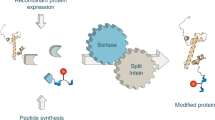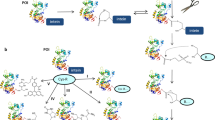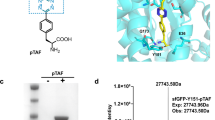Abstract
Expressed protein ligation is a valuable method for protein semisynthesis that involves the reaction of recombinant protein C-terminal thioesters with N-terminal cysteine (N-Cys)-containing peptides, but the requirement of a Cys residue at the ligation junction can limit the utility of this method. Here we employ subtiligase variants to efficiently ligate Cys-free peptides to protein thioesters. Using this method, we have more accurately determined the effect of C-terminal phosphorylation on the tumor suppressor protein PTEN.
This is a preview of subscription content, access via your institution
Access options
Subscribe to this journal
Receive 12 print issues and online access
$259.00 per year
only $21.58 per issue
Buy this article
- Purchase on Springer Link
- Instant access to full article PDF
Prices may be subject to local taxes which are calculated during checkout


Similar content being viewed by others
References
Vila-Perelló, M. & Muir, T.W. Cell 143, 191–200 (2010).
Sun, S.B., Schultz, P.G. & Kim, C.H. Chembiochem. 15, 1721–1729 (2014).
Chen, Z. & Cole, P.A. Curr. Opin. Chem. Biol. 28, 115–122 (2015).
Schmohl, L. & Schwarzer, D. Curr. Opin. Chem. Biol. 22, 122–128 (2014).
Muir, T.W., Sondhi, D. & Cole, P.A. Proc. Natl. Acad. Sci. USA 95, 6705–6710 (1998).
Evans, T.C. Jr., Benner, J. & Xu, M.-Q. Protein Sci. 7, 2256–2264 (1998).
Brooks, D.J., Fresco, J.R., Lesk, A.M. & Singh, M. Mol. Biol. Evol. 19, 1645–1655 (2002).
Loibl, S.F., Harpaz, Z. & Seitz, O. Angew. Chem. Int. Edn. Engl. 54, 15055–15059 (2015).
Machova, Z., von Eggelkraut-Gottanka, R., Wehofsky, N., Bordusa, F. & Beck-Sickinger, A.G. Angew. Chem. Int. Edn. Engl. 42, 4916–4918 (2003).
Abrahmsén, L. et al. Biochemistry 30, 4151–4159 (1991).
Chang, T.K., Jackson, D.Y., Burnier, J.P. & Wells, J.A. Proc. Natl. Acad. Sci. USA 91, 12544–12548 (1994).
Jackson, D.Y. et al. Science 266, 243–247 (1994).
Braisted, A.C., Judice, J.K. & Wells, J.A. Methods Enzymol. 289, 298–313 (1997).
Takeuchi, Y., Satow, Y., Nakamura, K.T. & Mitsui, Y. J. Mol. Biol. 221, 309–325 (1991).
Jain, S.C., Shinde, U., Li, Y., Inouye, M. & Berman, H.M. J. Mol. Biol. 284, 137–144 (1998).
Bolduc, D. et al. eLife 2, e00691 (2013).
Masson, G.R., Perisic, O., Burke, J.E. & Williams, R.L. Biochem. J. 473, 135–144 (2016).
Nguyen, H.N. et al. Oncogene 33, 5688–5696 (2014).
Qiao, Y., Molina, H., Pandey, A., Zhang, J. & Cole, P.A. Science 311, 1293–1297 (2006).
Henager, S.H. et al. Method of enzyme-catalyzed expressed protein ligation. Protocol Exchange http://dx.doi.org/10.1038/protex.2016.059 (2016).
Chen, Z. et al. J. Biol. Chem. 291, 14160–14169 (2016).
Acknowledgements
This work was supported by the NIH and the FAMRI foundation. We thank Y. Li for assisting with insect and mammalian cell culture. We thank the Stivers Lab (Johns Hopkins School of Medicine) for providing us with MEF cells. We thank A. Liu for assisting with the ubiquitin studies, and we thank the other members of the Cole Lab for valuable discussions and advice.
Author information
Authors and Affiliations
Contributions
S.H.H., N.C., J.W., and P.A.C. designed experiments. S.H.H., N.C., and Z.C. carried out experiments. S.H.H., N.C., Z.C., D.B., D.R.D., and Y.H. analyzed data. S.H.H., N.C., and P.A.C. drafted the manuscript, and all authors contributed to editing it to produce the final version.
Corresponding author
Ethics declarations
Competing interests
The authors declare no competing financial interests.
Integrated supplementary information
Supplementary Figure 1 Subtiligase-catalyzed ligations with ubiquitin thioesters and 10-mer biotinylated peptides.
(a) General scheme for ligations between ubiquitin thioesters and 10-mer, biotinylated peptides. (b) Representative SDS-PAGE analysis of the purification of an ubiquitin-MESNA thioester. MW, molecular weight markers; T, total cell pellet; L, E. coli cell lysate; R, chitin resin; E1 and E2, elutions from chitin resin. (c) SDS-PAGE analysis of subtiligase treatment of recombinant ubiquitin thioester (top) or standard ubiquitin (bottom) with peptide 1 (P1′ P2′ = GL). MW, molecular weight markers; N, no subtiligase control. (d) SDS-PAGE analysis of subtiligase-catalyzed ligations between Ubiquitin-MESNA (P4 P1 = LY) and the indicated peptides (peptides 2-4, and 6-10, Supp. Table 3). Representative of two replicates as reported in Supplemental Table 1. (e) SDS-PAGE analysis of subtiligase-catalyzed ligations between the indicated Ubiquitin-MESNA construct and peptide 1 (P1′ P2′ = GL). Representative of two replicates as reported in Supplemental Table 1.
Supplementary Figure 2 Mass spectrometry analysis of the ligation product of ubiquitin and peptide 1 (P1′ P2′ = GL).
(a) MALDI-MS measurement of ligation product of G76Y ubiquitin (P4 P1 = LY) and peptide 1 (P1′ P2′ = GL) purified by mono-avidin beads via a C-terminal biotin on peptide 1 (Supplemental Table 3). (b) Purification of ligation product by mono-avidin agarose chromatography. MW, molecular weight markers, Lane 1, ligation reaction before loaded on mono-avidin agarose; lane 2, flow-through from mono-avidin agarose. The agarose was washed with PBS buffer and the biotinylated ligation product was eluted with 2 mM biotin in PBS buffer. The eluate with 2.5 µg of ligation product was subjected to trypsin digestion with 50 ng trypsin in 50 mM Tris-HCl, pH 8.0 at 37oC for 3 hrs and stopped by 0.1% TFA, and analyzed by MALDI-MS. (c) MALDI-MS measurement of tryptic digestion with the mass of the fragment containing the ligation site highlighted. MS data was analyzed using the Protein Analysis Worksheet (Genomic Solutions) as shown in (d) demonstrating excellent correspondence between the calculated and observed masses for the peptide fragment containing the ligation site (red box).
Supplementary Figure 3 Analysis of subtiligase-mediated ubiquitin thioester hydrolysis.
Ubiquitin-MESNA was incubated with subtiligase for 5 minutes at 25oC and then quenched with 1% TFA in water prior to MALDI-MS analysis. A negative control without subtiligase is included for comparison. (a) MALDI-MS measurements for Ubiquitin-MESNA with (right) or without (left) subtiligase treatment. (b) Schematic showing proposed partitioning of the acylated enzyme intermediate between aminolysis and hydrolysis.
Supplementary Figure 4 Generation of Y217K subtiligase to improve the efficiency of ligations with acidic residues at the ligation junction.
Y217K subtiligase was designed and prepared based on structural studies on subtilisin and its potential to complement acidic residues at the P1′ position. (a) Introducing the Y217K mutation in the active site of subtilisin. The catalytic triad Ser/Cys221, His64 and Asp32, as well as Pro225 are highlighted. Left: crystal structure of subtilisin complexed with a chymotrypsin inhibitor (pink) containing a Glu residue in the P1′ site (adapted from PDB: 2SNI). Right: crystal structure of S221C, Y217K subtilisin with the sidechain of Lys217 oriented toward His64 and potentially complementary to acidic residues in the P1′ site (adapted from PDB: 1SUD). (b) Coomassie-stained SDS-PAGE of purified subtiligase variants. MW, molecular weight markers. (c) SDS-PAGE analysis of ligations between Ubiquitin-MESNA (P4 P1 = LE) and peptides 1 and 5 (Supplemental Table 3). (d) SDS-PAGE analysis of ligations between Ubiquitin-MESNA (P4 P1 = LD) and peptides 1 and 5. Abbreviations used: Std, standard subtiligase; QK, E156Q-G166K subtiligase; Y217K, Y217K subtiligase.
1. Pantoliano, M. W. et al. Biochemistry 28, 7205–7213 (1989).
2. McPhalen, C. A. & James, M. N. Biochemistry 27, 6582–6598 (1988).
3. Gallagher, T., Bryan, P. & Gilliland, G. L. Proteins 16, 205–213 (1993).
Supplementary Figure 5 Comparative kinetics between native chemical ligation and subtiligase-catalyzed ligation.
(a) Native chemical ligation. (b) Subtiligase-catalyzed ligation. MW, molecular weight markers. Each ligation was run twice and the span of values is shown (c). Each reaction contained 100 µM ubiquitin thioester (P4 P1 = LY) and 3 mM peptide. Peptides 11 (P1′ P2′ = CR) and 1 (P1′ P2′ = GL) were used for (a) and (b), respectively (Supplemental Table 3). 0.5 µM subtiligase was used for the subtiligase-catalyzed ligation. For native chemical ligation, the reaction was quenched by 50 mM cysteine on ice for 20 minutes and the excess of cysteine was removed by trichloroacetic acid precipitation.
Supplementary Figure 6 Subtiligase-catalyzed ligations with GST-thioesters and 10-mer biotinylated peptides.
(a) General scheme for ligations between GST-thioesters and 10-mer, biotinylated peptides. (b) Representative SDS-PAGE analysis of the purification of a GST-MESNA thioester. MW, molecular weight markers; L, E. coli cell lysate; FT, flow-through after loading lysate onto chitin resin; R, chitin resin; E, elution from chitin resin; C, concentrated GST-MESNA. (c) SDS-PAGE analysis of all GST-thioesters used for ligations. MW, molecular weight markers. (d) Western blot analysis of subtiligase-catalyzed ligations between the indicated GST-MESNA thioester and peptides 1-3 (Supplemental Table 3). Representative of two replicates as reported in Supplemental Table 2.
Supplementary Figure 7 Purification of r-PTEN-MESNA and semisynthetic PTEN.
(a) Representative SDS-PAGE analysis of the purification of r-PTEN-MESNA. MW, molecular weight markers; L, insect cell lysate; C, lysate after cellulose treatment; FT, flow-through after loading lysate onto chitin resin; E, elution from chitin resin. (b) Representative size-exclusion chromatogram and SDS-PAGE analysis of PTEN ligation. MW, molecular weight markers. (c) Representative SDS-PAGE analysis of monoavidin purification of semisynthetic PTEN. MW, molecular weight markers; Lane 1, 0.5 M NaCl wash; Lane 2, 1 M NaCl wash; Lane 3, 150 mM NaCl rinse; Lanes 4-7, 10 mM biotin elution; Lane 8, r-PTEN-MESNA. (d) SDS-PAGE gel showing purified PTEN variants. MW, molecular weight markers. (e) Anti-phosphorylated-PTEN antibodies respond more strongly to Y379-4p-PTEN than to C379-4p-PTEN. Each image is normalized to the C379-4p-PTEN band.
Supplementary Figure 8 MALDI-MS analyses of peptides used in this work.
(a-l) Mass spectra of the indicated peptides.
Supplementary information
Supplementary Text and Figures
Supplementary Figures 1–8, Supplementary Tables 1–3 and Supplementary Protocol (PDF 1172 kb)
Rights and permissions
About this article
Cite this article
Henager, S., Chu, N., Chen, Z. et al. Enzyme-catalyzed expressed protein ligation. Nat Methods 13, 925–927 (2016). https://doi.org/10.1038/nmeth.4004
Received:
Accepted:
Published:
Issue Date:
DOI: https://doi.org/10.1038/nmeth.4004
This article is cited by
-
Nature-inspired protein ligation and its applications
Nature Reviews Chemistry (2023)
-
The structural basis of PTEN regulation by multi-site phosphorylation
Nature Structural & Molecular Biology (2021)
-
Deciphering protein post-translational modifications using chemical biology tools
Nature Reviews Chemistry (2020)
-
Protein engineering through tandem transamidation
Nature Chemistry (2019)
-
Stabilization of Proteins by Covalent Cyclization
Biotechnology and Bioprocess Engineering (2019)



